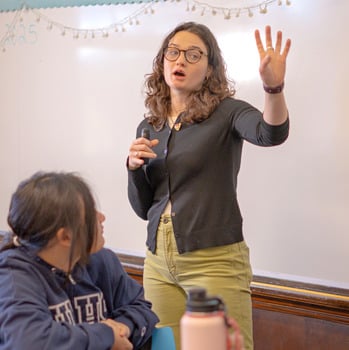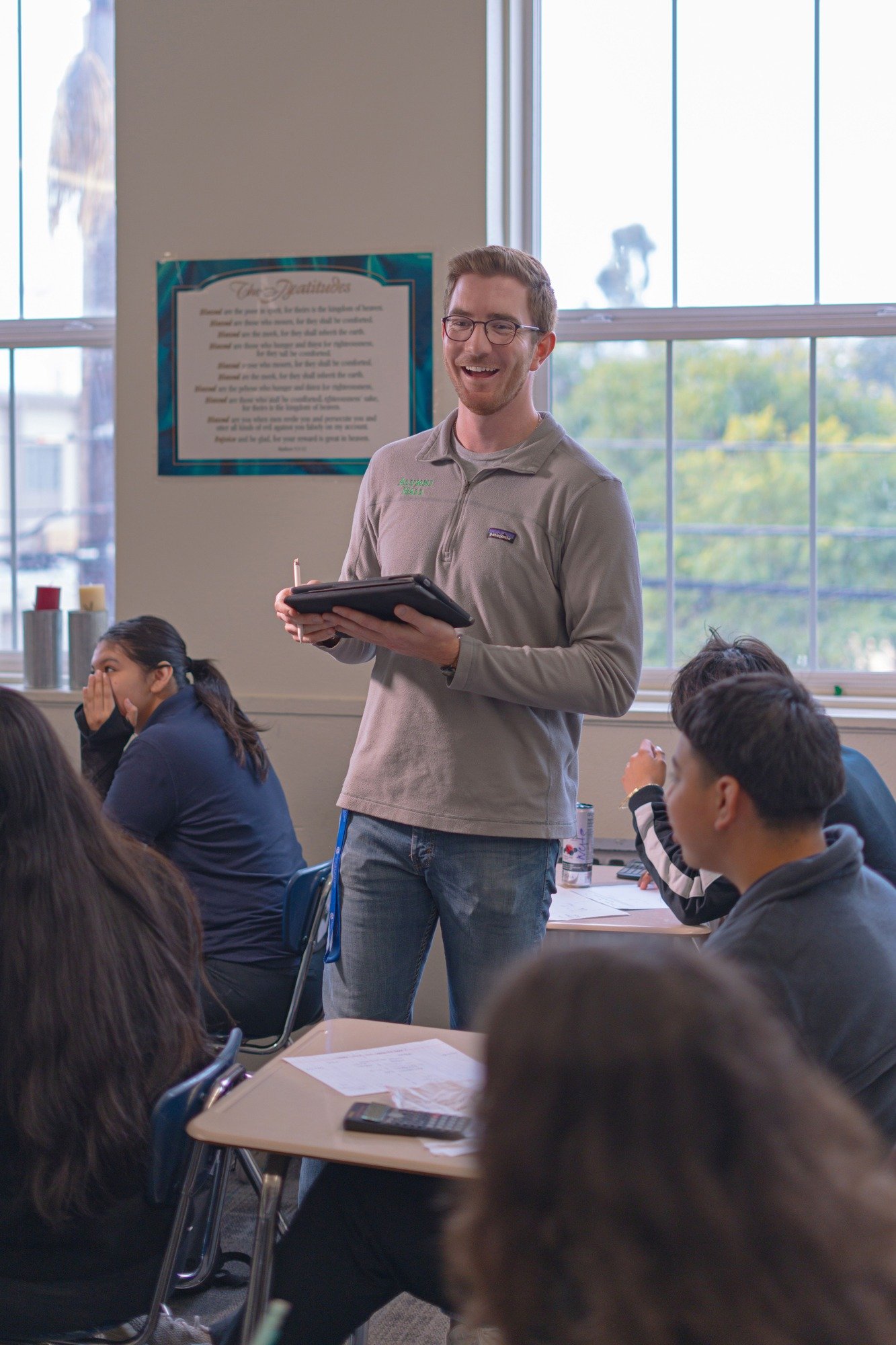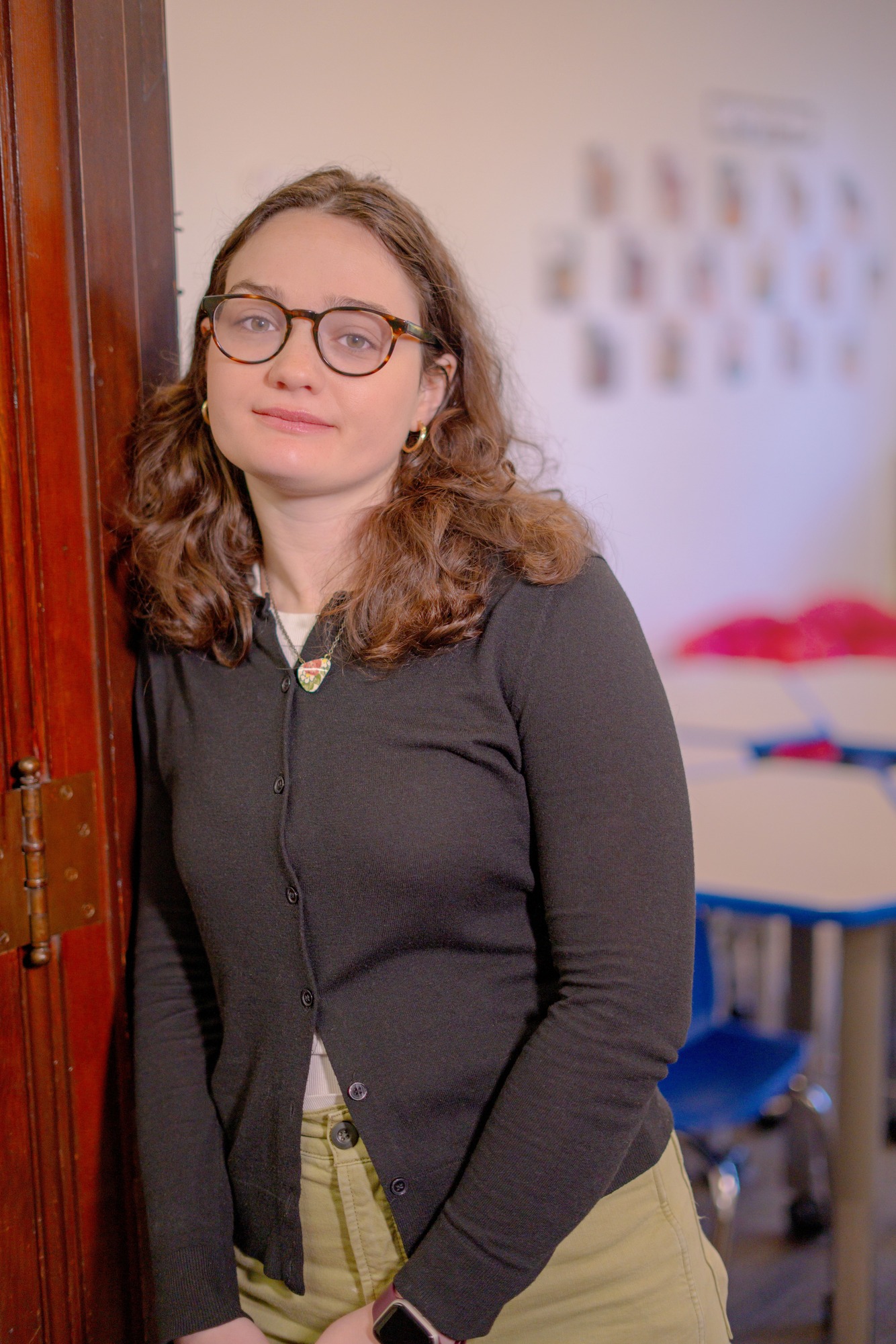'Relationships are everything': How ACE teachers impact Oakland Catholic students' lives
-
 Sometimes, they feel like they're working three full-time jobs. Sometimes, they don't even have their own designated spaces to teach.
Sometimes, they feel like they're working three full-time jobs. Sometimes, they don't even have their own designated spaces to teach.
Those are just rocks in the shoes along the cross-country career pathways of Oakland Catholic high school teachers Cam Nash and Grace Riginos. The teenagers who they get
to meet, impact and love every day make it worth the journey.
Called in their vocation to Oakland for a two-year teaching fellowship in the University of Notre Dame's Alliance for Catholic Education (ACE), Riginos and Nash are two of the six ACE teachers assigned to Oakland's Catholic schools in the 2024-25 academic year.
“Teaching is important, but relationships are everything,” said Riginos, who offers her presence to the young women learning at Holy Names High School. “Get to know the students and get involved in the school community. Celebrate them inside and outside the classroom.”
Nash and Riginos are two of the ACE Masters' degree students who have committed to two years of service at under-resourced schools across the United States, all while spending summers taking classes at Notre Dame and gaining experience in South Bend, Indiana's schools. 34 ACE teachers have served in the Diocese of Oakland in the program's 14-year history, giving an estimated 12,000 days to these Catholic school students who need positive relationships on their own journeys.Drawing stars, finding values
 Cam Nash is an ACE teacher assigned to Oakland's Catholic Schools.One late October day began for Nash by mentoring ninth-graders at Cristo Rey De La Salle East Bay High School. They each talk one-on-one with Nash. Often, it's to help get homework done. Sometimes, it's simply helping steer these young people's focus on their goals.
Cam Nash is an ACE teacher assigned to Oakland's Catholic Schools.One late October day began for Nash by mentoring ninth-graders at Cristo Rey De La Salle East Bay High School. They each talk one-on-one with Nash. Often, it's to help get homework done. Sometimes, it's simply helping steer these young people's focus on their goals.
But the business analytics major at Notre Dame decided to turn this morning into a Halloween pumpkin-carving day. That's not outside the realm of Nash's experience, as the former eagle scout and camp ranger in New Mexico who got degrees in business analytics and economics at Notre Dame also knows his way around carving tools.
Nash doesn't just juggle teaching Geometry, Algebra 2 and introductory Theology. He juggles rooms. His usual teaching room was out of commission on this day, so like his students, he shuttled between any available classroom to teach.
He started one class of 20 tenth-graders with a question reflective of many that these young people face in life, finding missing values. In this case, it's not as philosophical – they were simply looking for the missing value in two equal fractions.
In the process of teaching them how to check their answers, he reminds them of the butterfly method, where you cross-multiply, then divide by x. But Nash lets them know there's more than one way to solve these equations, and lets them know it's OK to use any one of numerous right ways to get to the answer – the kind of lesson he learned as a business analyst at a Catholic high school in San Diego.
They may someday forget the butterfly method. They more likely will remember Nash's lesson of knowing they can choose one of multiple objectively right ways to solve a problem they face in life.
Next, Nash shared a vocabulary lesson about geometrically similar figures, underlining his iPad with emphasis on the definition’s most important words. Instead of lines, he asked his students to draw a star next to a key example. Cam Nash teaches at Cristo Rey De La Salle East Bay High School.
Cam Nash teaches at Cristo Rey De La Salle East Bay High School.
A student joked, “I have to draw a picture of you, Mr. Nash, because you’re a star.”
Stars sometimes lose luster, and teachers sometimes make mistakes. Later in class, Nash made a mistake in solving an equation. When students pointed out his misstep, he took their correction, fixed the error, and with smooth direction, moved on from the error. Perhaps he’s teaching his students to emulate that when they stumble. Those student stumbles happen in his class, and he doles out discipline with required firmness and with good-naturedness. Rather than scream at a rowdy group who was asked to break off and work on trial problems, he sat down with them to keep them on task.
In addition to classroom interaction, lesson preparation and grading, Nash coaches boys volleyball and supervises National Honor Society peer-to-peer tutoring. In these long but rewarding days, he tries to implement what he calls the best piece of advice he ever received: Embracing positive affirmations, focusing and building on what goes well.
“Teaching is hard,” Nash admits. “It’s easy to feel like it’s not going your way and to focus on the students who you aren’t reaching or lessons that don’t hit as planned.”
Teaching Little Women, empowering women to grow Grace Riginos teaches freshman and sophomore English at Holy Names.Riginos, a former nanny and a graduate of Charlotte, North Carolina’s Catholic schools, easily relates to the all-girls atmosphere at Holy Names. She got her undergraduate English degree with an anthropology minor at all-women Barnard College in New York.“Being in an all-women school gave me confidence as a woman.… I felt empowered to share,” said Riginos. She considers Holy Names, where she teaches freshman and sophomore English, a natural fit.
Grace Riginos teaches freshman and sophomore English at Holy Names.Riginos, a former nanny and a graduate of Charlotte, North Carolina’s Catholic schools, easily relates to the all-girls atmosphere at Holy Names. She got her undergraduate English degree with an anthropology minor at all-women Barnard College in New York.“Being in an all-women school gave me confidence as a woman.… I felt empowered to share,” said Riginos. She considers Holy Names, where she teaches freshman and sophomore English, a natural fit.
“There is a fearlessness in the air. They are strong, intellectual young women.”
Riginos has shaken off some of her potential fears after more than a year of experience at Holy Names. She already knows many of her second-year students and is finding that one of her joys stems from expanding her relationship with them into a second year.
That relationship allows for making mistakes, both for herself and for her students in the welcoming environment she has created for them.
“Mispronunciations are allowed and encouraged,” she says when a student makes an error while reading aloud.
A bust of Shakespeare with thin rose-colored glasses perched on his head sits in a front corner of the classroom next to a pink disco ball. The desks are arranged in clusters that encourage peer discussion. In a class of 10, the girls occupy the two clusters at the front of the room.
Class on this Friday morning began with Kahoot!, an online educational gaming platform. The topic for this quiz is practicing adjective phrases. After each question, unless there are 100% correct answers, Riginos reviews the sentences to reinforce understanding.’’
After the activity, class shifts to the book the sophomores are currently reading, Little Women, the Louisa May Alcott novel from the 19th century about four sisters – Meg, Jo, Beth and Amy March and their own coming of age. “Being in an all-women school gave me confidence as a woman"
“Being in an all-women school gave me confidence as a woman"
Although Riginos is teaching the book for the first time, she wrote her thesis on it. Titled “Rejecting Miss March,” her writing focused on Jo’s rejection of societal expectations for women of the era and the freedom girlhood gives her. The unit focuses on the transition from girlhood to womanhood in both the time of publication, 1868, and now – at a time her students are making that very same transition.
When given time to talk in groups, the girls dove right into spirited discussion, prompting Riginos to comment,
“You guys are acting like the March sisters right now,” to a particularly lively group.
They discuss the ways girlhood has changed as a result of social media. One student calls Amy “Instagram Amy,” a commentary on Amy’s desire to follow trends and be seen as an adult in society.
Another offers up this observation about current affairs: “Young girls are trying to grow up, and women are trying to recapture girlhood.”
While the young students Riginos and Nash mentor are growing up, discovering themselves and where God resides within it all at these Oakland Catholic schools, these two Notre Dame Masters’ students are immersing themselves in teenage girlhood and boyhood – and discovering their own reason, their calling and their impact.
They all come in relationship with the students they share their lives with every day.
“That,” said Nash, “is what makes it all worth it.
